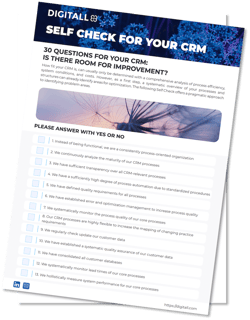CHECK YOUR CRM HEALTH
Identify performance gaps and opportunities to increase efficiency with these questions.
HOW HEALTHY IS YOUR CRM SETUP?
A CRM system is not just a set of tools that can be implemented and immediately changes everything. It needs to be adapted to your specific requirements, it needs the right processes for efficient use and it needs continuous monitoring to see if it needs a further update, a scaling down to save costs or even a replacement.
With 30 questions covering technology, strategy, processes and resources, you can find out how well your CRM is set up to provide you with optimized efficiency, productivity and costs.
Get an overview of your CRM status quo and find out what can be further developed or needs to be changed for a future-proof success strategy?
Download your CRM Self Check
Just fill out this form and you shall receive.
Get your personal analysis
We help you turn the results into a CRM roadmap. Just contact us and receive a personal review and analysis of your CRM self check by one of our many CRM experts.
Tell me more
Tell us your industry, CRM pain points and potential goals and use cases if you like, so we can design our analysis according to your specific requirements.
You can also attach your filled out checklist, so our expert can prepare their analysis beforehand.
When is it time to change your CRM?
With large CRM projects, it is not always a question of deciding whether to implement a CRM. Often a migration to a new system is pending. But why would companies want to change their systems?

1. Standardization of processes
Some CRM market leaders are popular because they offer everything from a single source. That way, processes can be set up in a standardized way. Homogeneous processes are particularly advantageous and increase collaboration when different divisions of a company, international offices, branches or partners work closely together. Sources of error are reduced and reports can be shared and adapted for different business units, since they come from a single source.
2. Compatibility with other applications
Hardly any older company simply uses the standard software of the provider. It is quite normal that individual solutions and functions are added over the years, some of which are developed in-house. However, sometimes a new update creates a situation where these solutions are no longer compatible and require alternatives or another system that still promises compatibility.
3. Consolidation of data
One of the biggest challenges with the highest pay-off is the consolidation of all data to guarantee the 360° customer view. Often, data gets stuck in the individual systems and creates silos. With the migration to a CRM of a provider, whose marketing or service solution is already in use, data can be consolidated much easier.
A new system might also enable new ways to synchronize data through interfaces (more on this below), in real time and with a single taxonomy.
4. Scope of functions
Sometimes, a company grows out of its "old" CRM or needs new or different functions. With the growing diversity of CRM solutions, it's more likely that the grass is greener on the other CRM side. For example, some CRM systems are more beneficial than others for certain industries, target groups, purposes, or compliance requirements. Or a CRM system allows many more apps, add-ons or interfaces.
5. From on-premise to the cloud
The migration to a cloud-based CRM can revolutionize virtual and mobile working. From real-time synchronization of on-site customer conversations to remote work, the cloud enables centralized, digital data storage and a workplace that travels with the employee. Cloudbased apps in particular offer many new ways for both customers and employees to interact with your company.
6. UX (for employees and partners)
Clumsy systems that are impenetrable are a thing of the past. Digitization also brings a democratization of software with it by making it increasingly user-friendly. The focus should not only be on how easily the customer can use something, but also how well employees can handle a software.
After all, if it is bulky and expensive, the usage rate drops and you risk the use of undocumented "shadow IT" or the dreaded Excel lists that are only accessible to single teams or colleagues.
A modern CRM must reduce workload and even make it fun to use. If a system is stronger in automating processes or generating measured values, the quality of the application will also increase.
7. Interfaces for other systems
I have mentioned interfaces a few times in this text. There are hardly any companies that use only one single system for digital transformation. A good interface ensures that data can "flow", systems understand each other, and no silos are created anywhere. In addition, linked systems can create new opportunities for alignment of business units, partnerships, etc.
8. Data protection & compliance
Especially in Europe, data protection plays a major role and can be critical to the company. Especially, when it comes to automating customer processes and storing and using sensitive data. Not every CRM system is up to this challenge. A CRM system also may have a simpler solution for data protection and compliance requirements than others and replace many manual rules with predefined, automated processes.
9. Cost-benefit
At the end of the day, it's always important how much a system costs and how efficient it is. An inexpensive system that is time-consuming to use may ultimately cost more than an expensive system that reduces time spent on tasks. Similarly, a large, expensive CRM system may be far too complex for a company whose customer-centric processes do not require all of the functionality.
Our DIGITALL experts offer you numerous services and products to enhance your CRM and fulfil your industry requirements. Find out more on our service page.


